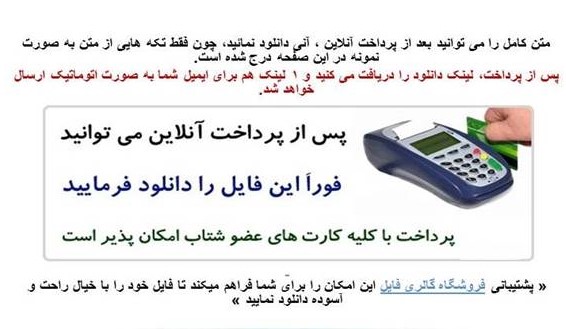لینک دانلود و خرید پایین توضیحات
فرمت فایل word و قابل ویرایش و پرینت
تعداد صفحات: 34
ضربالمثلهای انگلیسی به همراه معادل فارسی
"A poor workman blames his tools."
ترجمه: «کارگر بیمهارت، ابزار کارش را مقصر میداند.»
متراف فارسی: «عروس نمیتوانست برقصد، میگفت زمین ناهموار است.»
"A bird in the hand is worth two in the bush."
ترجمه«یک پرنده در دست، بهتر از دوتا روی درخت است.»
مترادف فارسی: «سرکه نقد به از حلوای نسیه.»
"Absence makes the heart grow fonder."
ترجمه: «دوری باعث علاقمندی می شود.»
مترادف فارسی: «دوری و دوستی.»
"A cat may look at a king."
ترجمه: «شاید که گربه به شاهی نظر کند.»
مترادف فارسی: «به اسب شاه گفته یابو.»
"A chain is no stronger than its weakest link."
ترجمه: «استحکام زنجیر به اندازه ضعیفترین حلقه آن است.» ویلیام شکسپیر در نمایشنامه ژولیوس سزار
"A coward dies a thousand times before his death. The valiant never taste of death but once."
ترجمه: «ترسو هزاربار پیش از مرگ میمیرد. آدم نترس فقط یکبار مزه مرگ را میچشد.»
مترادف فارسی: «ترس برادر مرگ است.»
مترادف فارسی: «ترسو مرد!»
"A creaking door hangs longest." and "A creaking gate hangs long."
ترجمه: «دری که غژغژ میکند عمرش بیشتر است.»
"Actions speak louder than words."
ترجمه: «صدای عمل رساتر از حرف است.»
مترادف فارسی: «به عمل کار برآید به سخندانی نیست.»
"Advice when most needed is least heeded."
ترجمه: «هرجا که پند و اندرز لازم آید، کمتر گوش شنوا است»
"A fool and his money are easily parted."
ترجمه: «احمق و پولش به راحتی از هم جداشدنی هستند»
مشابه فارسی:"تا ابله در جهانه، مفلس در نمیماند"
"A fox smells its own lair first." and " A fox smells its own stink first."
ترجمه: «روباه بوی گندش را زودتر از دیگران استشمام میکند»
مترادف فارسی: «چوب را که بلند کنی، گربه دزده فرار میکند»
"A friend in need is a friend indeed."
ترجمه: «به هنگام نیاز، دوست واقعی شناخته میشود.»
مترادف فارسی: «دوست آن باشد که گیرد دست دوست// در پریشانحالی و درماندگی»
"After a storm comes a calm."
ترجمه: «پس از طوفان، آرامش گسترده میگردد.»
مشابه فارسی: «بعد از خشم پشیمانی است»
"After dinner sit a while, after supper walk a mile."
ترجمه: «بعد از نهار کمی استراحت کنید، بعد از شام یک کیلومتر راه بروید.»
"A good beginning makes a good ending."
ترجمه: «یک شروع خوب، پایان خوبی در پی دارد.»
خلاف فارسی: «خشت اول چون نهد معمار کج// تا ثریا می رود دیوار کج» مولوی
"A good man in an evil society seems the greatest villain of all."
ترجمه: «انسان نیک در جمع اشرار، شریرترین آنها به نظر میرسد.»
"A good surgeon has an eagle's eye, a lion's heart, and a lady's hand."
ترجمه: «یک جراح خوب دارای چشمی همانند عقاب، دلی مثل شیر و دستی زنانه است.»
"A guilty conscience needs no accuser."
ترجمه: «یک وجدان گناهکار به سرزنش دیگران محتاج نیست»
"A jack of all trades is master of none."
ترجمه: «کسی که همهکار انجام میدهد استاد هیچکاری نیست.»
مترادف فارسی: « همهکاره و هیچکاره.»
"A lie has no legs."
ترجمه: «دروغ پا ندارد.»
مترادف فارسی: «دروغگو تا در خانهاش.»
"A lie can be halfway around the world before the truth gets its boots on."
ترجمه: «حقیقت تا چکمههایش را بپوشد، دروغ نیمی از جهان را دور زده است.» منسوب به وینستون چرچیل
"A little knowledge is a dangerous thing."
ترجمه: «دانش ناقص خطرناک است.»
مترادف فارسی: «نیمطبیب خطر جان، نیمفقیه خطر ایمان»
تمثیل: «دوکس دشمن ملک و دینند یکی پادشاه بی حلم و دیگری زاهد بی علم» سعدی
تمثیل: «آنکه نداند رقمی بهر نام// به ز فقیهی که بود ناتمام» امیر خسرو
"A merry heart makes a long life."
ترجمه: «دلشاد بودن، عمر انسان را طولانی میکند.»
A miss by an inch is a miss by a mile.
ترجمه: «لغزش در عمل چه یک اینچ، چه یک مایل.»
مترادف فارسی: «آب که از سر گذشت چه یک وجب چه صد وجب»
"A penny saved is a penny earned." منسوب به فرانکلین
ترجمه: «هر پول سیاهی که پسانداز شود، سودی است که کسب شده است.»
مترادف: «قطره قطره است وانگهی دریا»
"A person is known by the company he keeps."
ترجمه: «شخص به اطرافیانش شناخته می شود»
مترادف فارسی: «تو اول بگو با کیان دوستی// پسآنگه بگویم که تو کیستی» سعدی
"A picture is worth a thousand words."
ترجمه: «تصویر از هزاران جمله گویاتر است»
مترادف فارسی: «زلیخا گفتن و یوسف شنیدن// شنیدن کی بود مانند دیدن»
"A pot of milk is ruined by a drop of poison."
ترجمه: «یک بادیه پر از شیر به قطرهای زهر، فاسد میگردد»
"A rolling stone gathers no moss."
ترجمه: «بر سنگ غلطان سبزه نروید»
مترادف فارسی: «که بر سنگ گردان نروید نبات» سعدی
"A sound mind in a sound body."
ترجمه: «مغز سالم در بدن سالم»
اصل لاتینی: «mens sana in corpore sano»
مترادف فارسی: «عقل سالم در بدن سالم است»
منسوب به بنیامین فرانکلین "A stitch in time saves nine."
ترجمه: «یک ضربه بموقع، باعث صرفهجویی در نه ضربه دیگر است»
مترادف فارسی: «یک ضربه کاری از ضربات بعدی جلوگیری میکند»
"All cats love fish but hate to get their paws wet."
ترجمه: «هر گربهای ماهی را دوست دارد اما از اینکه پنجولش خیس شود بیزار است»
"All flowers are not in one garland."
ترجمه: «هیچ گلستانی تمام انواع گلها را ندارد»
مترادف فارسی: «گل بیعلت و بیعیب خداست» پروین اعتصامی
"All frills and no knickers."

تحقیق درموردمتن انگلیسی ضرب المثل انگلیسی به همراه معادل فارسی